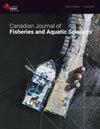北极双桨物种的全年监测,以确定其活动行为的居住和季节性
IF 2.2
2区 农林科学
Q2 FISHERIES
Canadian Journal of Fisheries and Aquatic Sciences
Pub Date : 2023-08-03
DOI:10.1139/cjfas-2023-0042
引用次数: 0
摘要
环境随时间和空间的变化而变化,通常需要生物体表现出行为反应。在北极,春季的资源促使迁徙的消费者跟随消退的冰;然而,居民物种对这种短暂生产力的反应却不太清楚。研究了加拿大努纳武特地区Tremblay Sound地区相对定居的北极物种(Myoxocephalus spp.)的运动行为。通过一系列声波遥测接收器(n = 37)全年监测2017-2019年无冰期捕获的个体(n = 60)的运动。遥测数据证实了它们全年都居住在海湾内,但与冰雪覆盖的冬季相比,在无冰期间,雕塑始终更加活跃,范围更广。序列分析显示了不同的活动模式,主要由区域关联区分。总之,这些结果表明,石雕鱼是久坐不动的,但在无冰季节活动更多,这表明季节性生产力脉动对这些鱼的重要性。作为适应利用当地环境条件的常驻物种,石雕为监测正在经历快速变化的北极沿海和底栖生态系统提供了有价值的指示物种。本文章由计算机程序翻译,如有差异,请以英文原文为准。
Year-round monitoring of Arctic species of sculpin to identify residency and seasonality of movement behavior
Environments change across space and time, often requiring organisms to exhibit behavioral responses. In the Arctic, migratory consumers are motivated by spring resources to follow receding ice; however, resident species’ responses to this ephemeral productivity are less well understood. We characterized the movement behaviors of relatively sedentary Arctic species of sculpin (Myoxocephalus spp.) in Tremblay Sound, Nunavut, Canada. Movements of individuals (n = 60) captured during the ice-free periods of 2017-2019 were monitored year-round via an array of acoustic telemetry receivers (n = 37). Telemetry data confirmed year-round residency within the Sound, yet sculpins were consistently more active and wider ranging during the ice-free period versus the ice-covered winters. Sequence analysis revealed distinct patterns of activity differentiated primarily by regional associations. Together, these results indicate sculpin are highly sedentary, but move more during the ice-free season, suggesting the importance of the seasonal productivity pulse to these fish. As resident species adapted to exploit the conditions within their local environment, sculpin provide a valuable indicator species to monitor coastal and benthic Arctic ecosystems that are experiencing rapid change.
求助全文
通过发布文献求助,成功后即可免费获取论文全文。
去求助
来源期刊

Canadian Journal of Fisheries and Aquatic Sciences
农林科学-海洋与淡水生物学
CiteScore
4.60
自引率
12.50%
发文量
148
审稿时长
6-16 weeks
期刊介绍:
The Canadian Journal of Fisheries and Aquatic Sciences is the primary publishing vehicle for the multidisciplinary field of aquatic sciences. It publishes perspectives (syntheses, critiques, and re-evaluations), discussions (comments and replies), articles, and rapid communications, relating to current research on -omics, cells, organisms, populations, ecosystems, or processes that affect aquatic systems. The journal seeks to amplify, modify, question, or redirect accumulated knowledge in the field of fisheries and aquatic science.
 求助内容:
求助内容: 应助结果提醒方式:
应助结果提醒方式:


